rear wheel YAMAHA XMAX 300 2022 Owners Manual
[x] Cancel search | Manufacturer: YAMAHA, Model Year: 2022, Model line: XMAX 300, Model: YAMAHA XMAX 300 2022Pages: 116, PDF Size: 4.64 MB
Page 8 of 116

Table of contentsSafety information ............................ 1-1
Further safe-riding points ............... 1-5
Description ....................................... 2-1
Left view ......................................... 2-1
Right view ....................................... 2-2
Controls and instruments ............... 2-3
Smart key system ........................... 3-1
Smart key system ........................... 3-1
Operating range of the smart key system......................................... 3-2
Handling of the smart key and mechanical keys ......................... 3-3
Smart key ....................................... 3-5
Replacing the smart key battery..... 3-6
Main switch .................................... 3-8
Instrument an d control functions ... 4-1
Indicator lights and warning
lights............................................ 4-1
Speedometer .................................. 4-3
Tachometer .................................... 4-3
Multi-function display ..................... 4-4
Handlebar switches ...................... 4-12
Front brake lever .......................... 4-13
Rear brake lever ........................... 4-14
Anti-lock brake system (ABS)....... 4-14
Traction control system ................ 4-15
Fuel tank cap ................................ 4-17
Fuel ............................................... 4-18 Fuel tank overflow hose ................ 4-19
Catalytic converter ........................ 4-20
Storage compartments ................. 4-20
Windshield .................................... 4-22
Handlebar position ....................... 4-24
Adjusting the shock absorber
assemblies ................................. 4-25
Auxiliary DC jack .......................... 4-25
Sidestand ...................................... 4-26
Ignition circuit cut-off system ....... 4-27
For your safety – pre-operation
checks ............................................... 5-1
Operation an d important ri din g
points ................................................. 6-1
Engine break-in ............................... 6-1
Starting the engine .......................... 6-2
Starting off ...................................... 6-3
Acceleration and deceleration ........ 6-3
Braking ............................................ 6-3
Tips for reducing fuel consumption ................................ 6-4
Parking ............................................ 6-4
Perio dic maintenance an d
a d justment ........................................ 7-1
Tool kit ............................................ 7-2
Periodic maintenance charts .......... 7-3
Periodic maintenance chart for the emission control system .............. 7-3 General maintenance and
lubrication chart .......................... 7-4
Removing and installing the panel............................................ 7-8
Checking the spark plug................. 7-9
Canister ........................................ 7-10
Engine oil and oil filter element..... 7-10
Final transmission oil .................... 7-13
Coolant ......................................... 7-14
Air filter and V-belt case air filter elements .................................... 7-15
Checking the throttle grip free play ............................................ 7-19
Valve clearance............................. 7-20
Tires .............................................. 7-20
Cast wheels .................................. 7-22
Checking the front and rear
brake lever free play .................. 7-22
Checking the front and rear brake pads ................................ 7-23
Checking the brake fluid level ...... 7-23
Changing the brake fluid .............. 7-25
Checking the V-belt ...................... 7-25
Checking and lubricating the cables ........................................ 7-25
Checking and lubricating the
throttle grip and cable ............... 7-26
Lubricating the front and rear brake levers ............................... 7-26
Checking and lubricating the centerstand and sidestand........ 7-27UBBAE1E0.book Page 1 Monday, October 4, 2021 4:51 PM
Page 9 of 116

Table of contents
Checking the front fork..................7-27
Checking the steering ...................7-28
Checking the wheel bearings ........7-28
Battery ...........................................7-29
Replacing the fuses .......................7-30
Headlights .....................................7-31
Auxiliary lights ...............................7-32
Brake/tail light ...............................7-32
Front turn signal light.....................7-32
Rear turn signal light bulb .............7-33
Replacing the license plate light
bulb ............................................7-33
Troubleshooting ............................7-34
Troubleshooting chart ...................7-35
Emergency mode .........................7-37
Scooter care an d stora ge ................8-1
Matte color caution .........................8-1
Care .................................................8-1
Storage ............................................8-3
Specifications ....................................9-1
Consumer information ...................10-1
Identification numbers ...................10-1
Diagnostic connector ....................10-2
Vehicle data recording ..................10-2
In dex ................................................11-1
UBBAE1E0.book Page 2 Monday, October 4, 2021 4:51 PM
Page 44 of 116
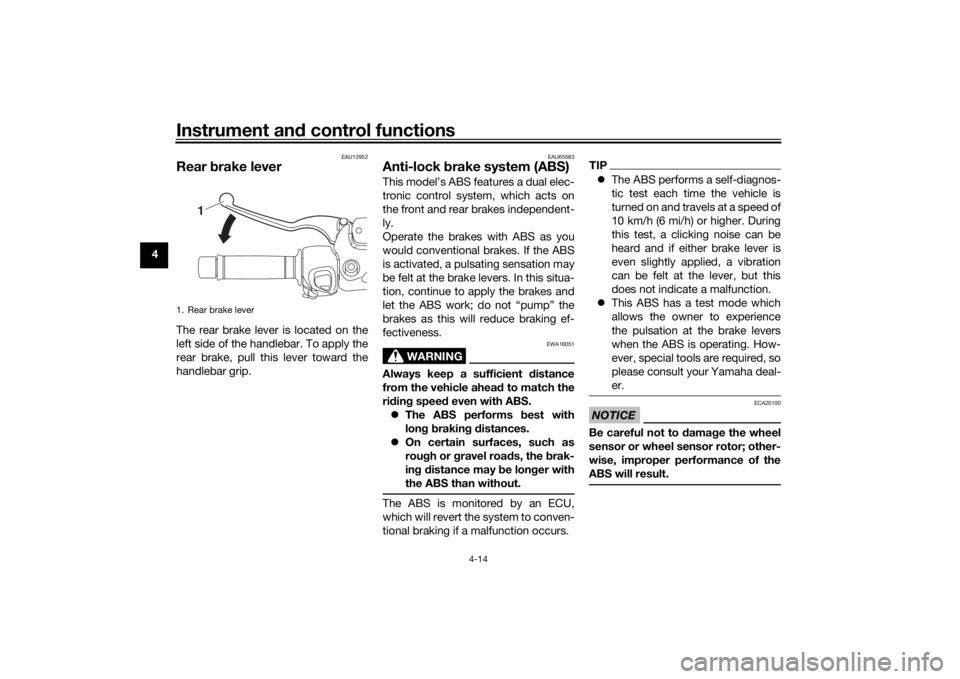
Instrument and control functions
4-14
4
EAU12952
Rear brake leverThe rear brake lever is located on the
left side of the handlebar. To apply the
rear brake, pull this lever toward the
handlebar grip.
EAU65583
Anti-lock brake system (ABS)This model’s ABS features a dual elec-
tronic control system, which acts on
the front and rear brakes independent-
ly.
Operate the brakes with ABS as you
would conventional brakes. If the ABS
is activated, a pulsating sensation may
be felt at the brake levers. In this situa-
tion, continue to apply the brakes and
let the ABS work; do not “pump” the
brakes as this will reduce braking ef-
fectiveness.
WARNING
EWA16051
Always keep a sufficient distance
from the vehicle ahea d to match the
ri din g spee d even with ABS.
The ABS performs best with
lon g b rakin g d istances.
On certain surfaces, such as
rou gh or g ravel roa ds, the b rak-
in g d istance may b e longer with
the ABS than without.The ABS is monitored by an ECU,
which will revert the system to conven-
tional braking if a malfunction occurs.
TIP The ABS performs a self-diagnos-
tic test each time the vehicle is
turned on and travels at a speed of
10 km/h (6 mi/h) or higher. During
this test, a clicking noise can be
heard and if either brake lever is
even slightly applied, a vibration
can be felt at the lever, but this
does not indicate a malfunction.
This ABS has a test mode which
allows the owner to experience
the pulsation at the brake levers
when the ABS is operating. How-
ever, special tools are required, so
please consult your Yamaha deal-
er.NOTICE
ECA20100
Be careful not to d amage the wheel
sensor or wheel sensor rotor; other-
wise, improper performance of the
ABS will result.
1. Rear brake lever
1
UBBAE1E0.book Page 14 Monday, October 4, 2021 4:51 PM
Page 45 of 116
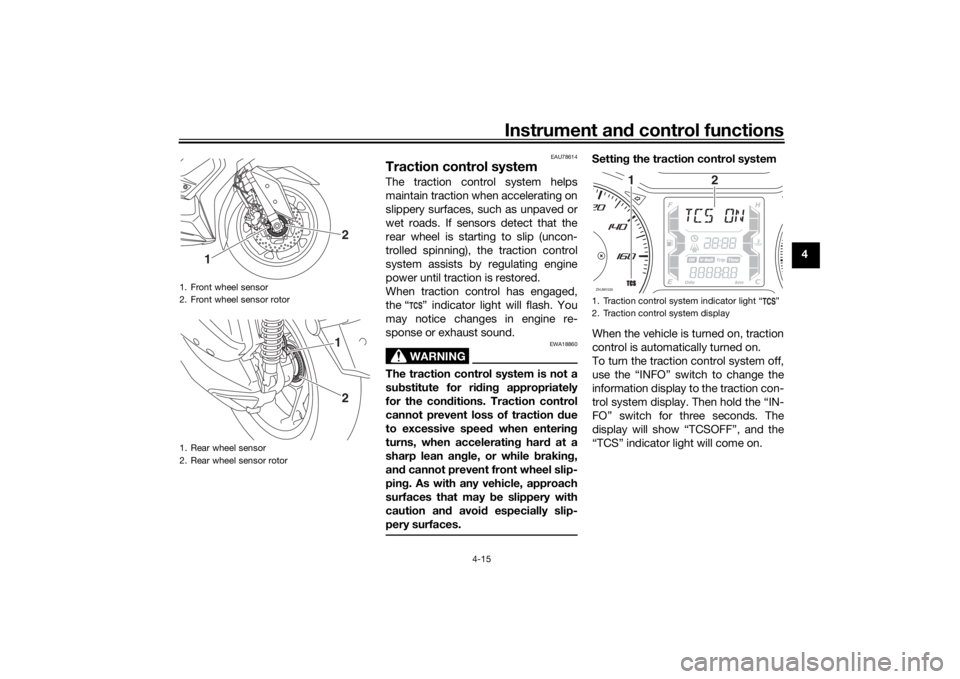
Instrument and control functions
4-15
4
EAU78614
Traction control systemThe traction control system helps
maintain traction when accelerating on
slippery surfaces, such as unpaved or
wet roads. If sensors detect that the
rear wheel is starting to slip (uncon-
trolled spinning), the traction control
system assists by regulating engine
power until traction is restored.
When traction control has engaged,
the “ ” indicator light will flash. You
may notice changes in engine re-
sponse or exhaust sound.
WARNING
EWA18860
The traction control system is not a
su bstitute for ri din g appropriately
for the con ditions. Traction control
cannot prevent loss of traction d ue
to excessive spee d when enterin g
turns, when acceleratin g har d at a
sharp lean an gle, or while brakin g,
an d cannot prevent front wheel slip-
pin g. As with any vehicle, approach
surfaces that may be slippery with
caution an d avoi d especially slip-
pery surfaces.
Settin g the traction control system
When the vehicle is turned on, traction
control is automatically turned on.
To turn the traction control system off,
use the “INFO” switch to change the
information display to the traction con-
trol system display. Then hold the “IN-
FO” switch for three seconds. The
display will show “TCSOFF”, and the
“TCS” indicator light will come on.
1. Front wheel sensor
2. Front wheel sensor rotor
1. Rear wheel sensor
2. Rear wheel sensor rotor
2
1
21
1. Traction control system indicator light “ ”
2. Traction control system displayZAUM1535
1
2
UBBAE1E0.book Page 15 Monday, October 4, 2021 4:51 PM
Page 46 of 116
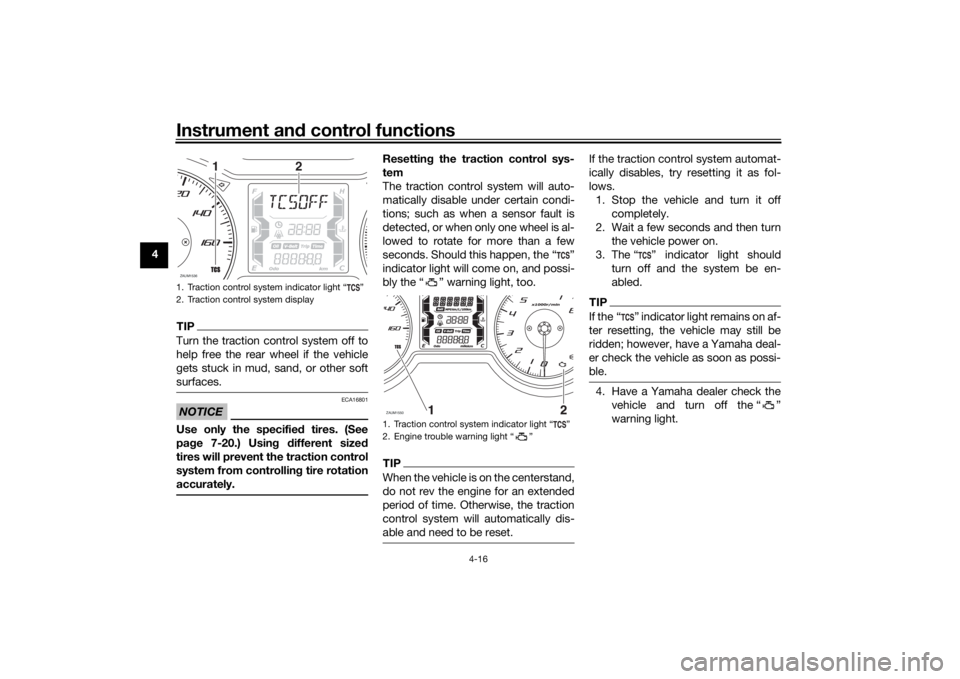
Instrument and control functions
4-16
4
TIPTurn the traction control system off to
help free the rear wheel if the vehicle
gets stuck in mud, sand, or other soft
surfaces.NOTICE
ECA16801
Use only the specified tires. (See
pa ge 7-20.) Usin g different size d
tires will prevent the traction control
system from controllin g tire rotation
accurately.
Resettin g the traction control sys-
tem
The traction control system will auto-
matically disable under certain condi-
tions; such as when a sensor fault is
detected, or when only one wheel is al-
lowed to rotate for more than a few
seconds. Should this happen, the “ ”
indicator light will come on, and possi-
bly the “ ” warning light, too.TIPWhen the vehicle is on the centerstand,
do not rev the engine for an extended
period of time. Otherwise, the traction
control system will automatically dis-
able and need to be reset.
If the traction control system automat-
ically disables, try resetting it as fol-
lows. 1. Stop the vehicle and turn it off completely.
2. Wait a few seconds and then turn the vehicle power on.
3. The “ ” indicator light should turn off and the system be en-
abled.TIPIf the “ ” indicator light remains on af-
ter resetting, the vehicle may still be
ridden; however, have a Yamaha deal-
er check the vehicle as soon as possi-
ble.4. Have a Yamaha dealer check thevehicle and turn off the “ ”
warning light.
1. Traction control system indicator light “ ”
2. Traction control system displayZAUM1536
1
2
1. Traction control system indicator light “ ”
2. Engine trouble warning light “ ”ZAUM1550
UBBAE1E0.book Page 16 Monday, October 4, 2021 4:51 PM
Page 60 of 116

For your safety – pre-operation checks
5-2
5
Rear brake • Check operation.
• If soft or spongy, have Yamaha dealer bleed hydraulic system.
• Check brake pads for wear.
• Replace if necessary.
• Check fluid level in reservoir.
• If necessary, add specified brake fluid to specified level.
• Check hydraulic system for leakage. 7-22, 7-23, 7-23
Throttle g rip • Make sure that operation is smooth.
• Check throttle grip free play.
• If necessary, have Yamaha dealer adjust throttle grip free play and lubricate ca-
ble and grip housing. 7-19, 7-26
Control ca bles • Make sure that operation is smooth.
• Lubricate if necessary. 7-25
Wheels an d tires •Check for damage.
• Check tire condition and tread depth.
• Check air pressure.
• Correct if necessary. 7-20, 7-22
Brake levers • Make sure that operation is smooth.
• Lubricate lever pivoting points if necessary.
7-26
Centerstan d, si destan d • Make sure that operation is smooth.
• Lubricate pivots if necessary.
7-27
Chassis fasteners • Make sure that all nuts, bolts and screws are properly tightened.
• Tighten if necessary. —
Instruments, li ghts, si gnals
an d switches • Check operation.
• Correct if necessary.
—
Si destan d switch • Check operation of ignition circuit cut-off system.
• If system is not working correctly, have Yamaha dealer check vehicle.
4-26
ITEM
CHECKS PAGE
UBBAE1E0.book Page 2 Monday, October 4, 2021 4:51 PM
Page 69 of 116

Periodic maintenance an d a djustment
7-4
7
EAU71353
General maintenance an d lu brication chartNO. ITEM CHECK OR MAINTENANCE JOB ODOMETER READING
ANNUAL
CHECK
1000 km
(600 mi) 10000 km
(6000 mi) 20000 km
(12000 mi) 30000 km
(18000 mi) 40000 km
(24000 mi)
1 *Dia
gnostic system
check • Perform dynamic inspection us-
ing Yamaha diagnostic tool.
• Check the error codes. √√√√√√
2 *Air filter element •Replace. √√
3 *Pre air filter element • Clean. √√
4 *Su
b air filter ele-
ment •Replace.
√√
5 Air filter case check
hose
• Clean.
√√√√√
6 *V-
belt case air filter
element • Clean.
• Replace if necessary.
√√√√√
7 *Front brake • Check operation, fluid level, and
for fluid leakage.
• Replace brake pads if necessary. √√√√√√
8 *Rear brake • Check operation, fluid level, and
for fluid leakage.
• Replace brake pads if necessary. √√√√√√
9 *Brake hoses • Check for cracks or damage.
√√√√√
• Replace. Every 4 years
10 *Brake flui d • Change. Every 2 years
11 *Wheels • Check runout and for damage.
• Replace if necessary. √√√√
UBBAE1E0.book Page 4 Monday, October 4, 2021 4:51 PM
Page 70 of 116

Periodic maintenance an d a djustment
7-5
7
12 *Tires • Check tread depth and for dam-
age.
• Replace if necessary.
• Check air pressure.
• Correct if necessary. √√√√√
13 *Wheel bearin gs • Check bearing for looseness or
damage. √√√√
14 *Steerin g b earin gs • Check bearing assemblies for
looseness. √√ √
• Moderately repack with lithium- soap-based grease. √√
15 *Chassis fasteners • Make sure that all nuts, bolts and
screws are properly tightened. √√√√√
16 Front an
d rear
b rake lever pivot
shaft • Lubricate with silicone grease.
√√√√√
17 Si
destan d, center-
stan d • Check operation.
• Lubricate with lithium-soap-
based grease. √√√√√
18 *Sidestan d switch • Check operation and replace if
necessary. √√√√√√
19 *Front fork • Check operation and for oil leak-
age.
• Replace if necessary. √√√√
20 *Shock a
bsor ber as-
sem blies • Check operation and for oil leak-
age.
• Replace if necessary. √√√√
NO. ITEM CHECK OR MAINTENANCE JOB
ODOMETER READING
ANNUAL
CHECK
1000 km
(600 mi) 10000 km
(6000 mi) 20000 km
(12000 mi) 30000 km
(18000 mi) 40000 km
(
24000 mi)
UBBAE1E0.book Page 5 Monday, October 4, 2021 4:51 PM
Page 83 of 116
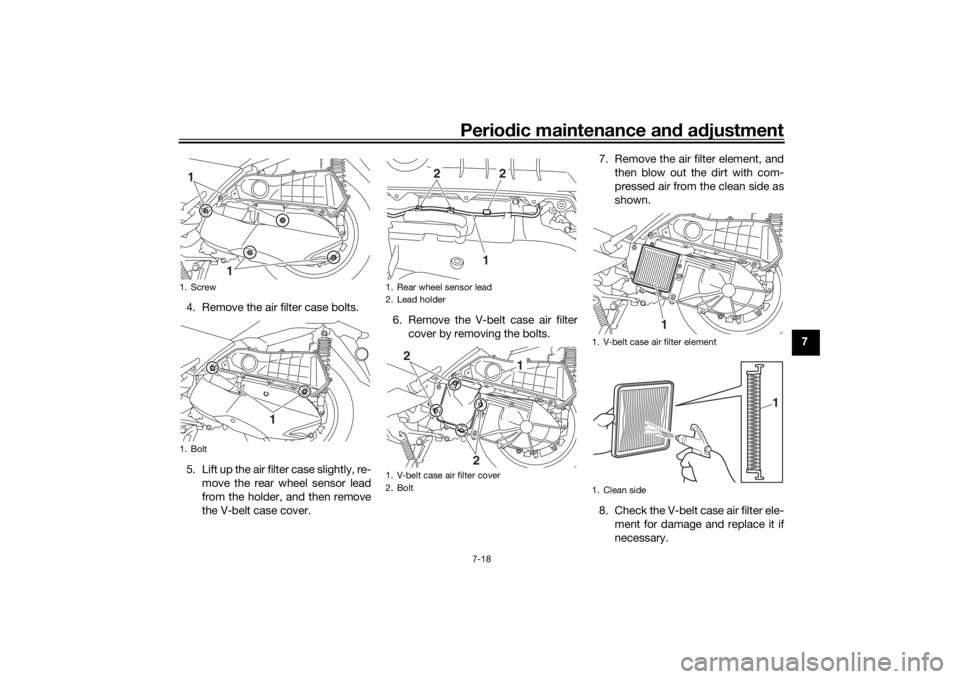
Periodic maintenance an d a djustment
7-18
7
4. Remove the air filter case bolts.
5. Lift up the air filter case slightly, re-
move the rear wheel sensor lead
from the holder, and then remove
the V-belt case cover. 6. Remove the V-belt case air filter
cover by removing the bolts. 7. Remove the air filter element, and
then blow out the dirt with com-
pressed air from the clean side as
shown.
8. Check the V-belt case air filter ele- ment for damage and replace it if
necessary.
1. Screw
1. Bolt
1
1
1
1. Rear wheel sensor lead
2. Lead holder
1. V-belt case air filter cover
2. Bolt
1
2
2
1
2
2
1. V-belt case air filter element
1. Clean side
1
1
UBBAE1E0.book Page 18 Monday, October 4, 2021 4:51 PM
Page 84 of 116
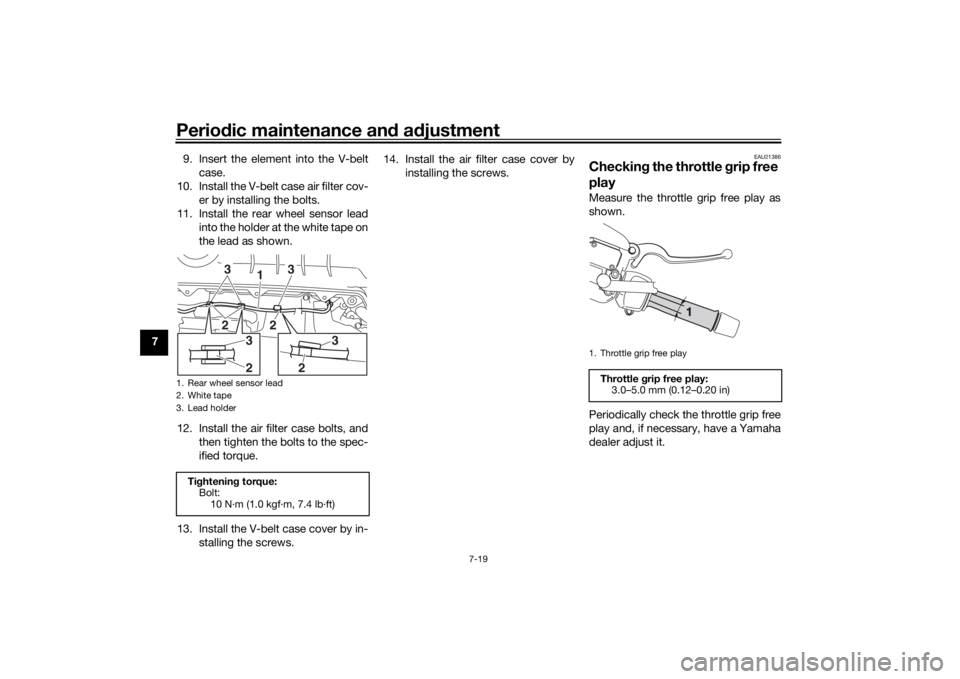
Periodic maintenance an d a djustment
7-19
7 9. Insert the element into the V-belt
case.
10. Install the V-belt case air filter cov- er by installing the bolts.
11. Install the rear wheel sensor lead into the holder at the white tape on
the lead as shown.
12. Install the air filter case bolts, and then tighten the bolts to the spec-
ified torque.
13. Install the V-belt case cover by in- stalling the screws. 14. Install the air filter case cover by
installing the screws.
EAU21386
Checkin g the throttle grip free
playMeasure the throttle grip free play as
shown.
Periodically check the throttle grip free
play and, if necessary, have a Yamaha
dealer adjust it.
1. Rear wheel sensor lead
2. White tape
3. Lead holderTi ghtenin g torque:
Bolt:
10 N·m (1.0 kgf·m, 7.4 lb·ft)
13
3
2
2
3
2
2
3
1. Throttle grip free playThrottle grip free play:
3.0–5.0 mm (0.12–0.20 in)
UBBAE1E0.book Page 19 Monday, October 4, 2021 4:51 PM